| STARSHIP | |

| |
| Ship Name: | USS Prometheus |
| Registry: | NX-59650 |
| Affiliation: | Federation Starfleet |
| Type: | Long range tactical cruiser |
| Class: | Prometheus |
| Status: | Active |
| CAREER | |
| Yard: | Beta Antares Fleet Yards |
| Laid down: | 2364 |
| Launched: | 2374 |
| Commissioned: | 2374 |
| Decommissioned: | Inapplicable |
| GENERAL CHARACTERISTICS | |
| Length: | 415 m m |
| Beam: | 170 m m |
| Draft: | 113 m m |
| Decks: | 16 |
| Propulsion: | Thrusters, Impulse drive, Quantum field assisted tetyron plasma warp drive |
| Speed: | Warp 9.99 |
| Complement: | 140 |
| Armament: | 18 Type-XII phaser emitters; 3 torpedo launchers |
| Shuttlecraft: | Prior to stardate 55118: 1 Type-11 shuttlecraft, 4 Type-9 shuttlecraft, 4 Workbees Subsequent to stardate 55118: 1 Yellowstone class runabout, 4 Type-9 shuttlecraft, 4 Workbees |
| Motto: | All the world's a stage and all the men and women merely players, they have their exits and their entrances and one man in his life plays many parts; his act being seven stages... - William Shakespeare |

| |
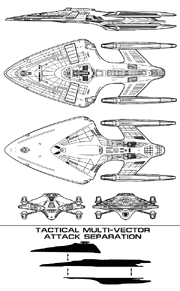
exterior schematic of the Prometheus

USS Prometheus Master Systems Display
A typical straight corridor
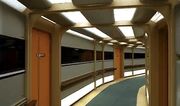
A typical curved corridor
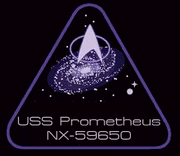
The crest created for the prototype ship by the Prometheus Project Staff
The USS Prometheus (NX-59650) is a Prometheus-class starship and was the first of its class. It was launched in 2374 and was under the command of Captain Logan MacLeod as of 2378. (Star Trek: Prometheus)
Starship History
The Prometheus-class was one of if not the the most advanced Starfleet vessels in service as of the late 24th century. The Prometheus underwent many extended trials (both simulated and physical) and is the culmination of several separate research projects which have been combined into one prototype test-bed vessel. Since it was so highly classified and possessed a hitherto unseen degree of automation only four Starfleet officers were trained on how to operate the Prometheus' systems before the vessel was deemed ready for active duty.
Among the Prometheus' state of the art features was the advanced type XII phaser arrays, quantum torpedoes, photon torpedoes, regenerative and Metaphasic shields augmented by a polaron modulator, and ablative armor with underlying Parametallic hull plating.
The Prometheus' warp engines which were designed to be the fastest in the fleet with a cruising speed of warp 9 and a maximum speed of warp 9.99 (due to its tetryon warp plasma equipped warp nacelles). With these speeds being standard it was deemed necessary to develop a customized navigation system, the RAV/ISHAK Mod 3a warp celestial guidance system, specifically designed to handle the ship's high warp capability. The warp engines of the Prometheus Class were based on a scaled down version of the Sovereign class' warp nacelle design, which eliminated subspace distortion effects inherent to standard warp drives without the use of variable geometry nacelles.
A unique feature included in the Prometheus design was the multi-vector assault mode, which allows the ship to split into three semi-independent sections (or fully independent sections if there are sufficient crew members onboard) that could each deliver massive force against an enemy target. All three sections are warp-capable. Combined with the extensive automation, the Prometheus can be run by as few as four people. To allow this system to function it was again deemed necessary to develop a customized system for the ship, this one being the M16a tri-core bio-neural gel pack isolinear III processor.
In addition to standard automation systems, the design also featured omni-directional holo-diodes on every deck, which allowed the ship's Emergency Medical Hologram (Mark II as of 2374. Mark IV as of 2378) to access all areas of the ship (most EMHs were confined to sickbay only).
Class History
The Prometheus Project was the research program initiated in 2359 as a project to design a starship whose sections each were equipped with a warp drive and reorganized into a combat ship program to develop the schematics for the Prometheus-class starship and construct the class prototype. When the project was re-organized into a combat ship design program in 2364 it was decided by Starfleet Command to keep the Nebula-class USS Prometheus in service as a cover for the Prometheus class Project.
The 2359 version of the Prometheus class Project was created to explore the possibility of a true multi-section vessel able to separate into at least two independent sections, each with a fully functional warp drive of its own. One would be capable of launching an attack with almost all of the ships weaponry, at high speed and maneuverability. The other, comprising the scientific, diplomatic and accommodation sections, would clear the area at high warp carrying the civilian complement. Much of the technology being developed for the Intrepid-class project was included in this design, with the result that the theoretical model finalized in 2363 bore a close resemblance to the Intrepid herself.
In 2364 Starfleet was considering moving to construction of the spaceframe of the multi-section starship. However, during this year contact with the Romulans was re-established when the USS Enterprise-D encountered a warbird at the Neutral Zone. Since the warbird appeared to outgun the Enterprise, then Starfleet’s most powerful ship, by a considerable margin Starfleet was confronted with what appeared to be a powerful and aggressive enemy. As part of their response, Starfleet requested a complete re-design of the multi-section starship. The new requirement called for an almost totally re-designed vessel; the ship would be capable of splitting into three sections, each of which would have an independent warp drive system. The scientific and diplomatic sections were mostly removed in favor of increased armament and power for the weapons. In place of the type-VIII phaser arrays that the original ship had shared with the Intrepid class, the type-XII phaser arrays from the Sovereign-class project were included. The shield system was upgraded with the auto-modulating shields of the Sovereign-class. The advanced warp engine design included many elements of the Sovereign-class, while the ablative armor, high capacity structural integrity fields and quantum torpedoes developed in conjunction with the Defiant-class project were also included. The computer system was upgraded to a custom built system designated the M16a tri-core bio-neural gel pack isolinear III processor and the navigational system installed was a custom RAV/ISHAK Mod 3a warp celestial guidance system specifically designed to handle the ship's cruising speed of Warp 9 and maximum speed of Warp 9.99.
This technology combined to make the new starship one of the most massively armed and armored vessels of its size ever contemplated, let alone built. The small size combined with incredible speed and maneuverability when in multi-vector assault mode.
When the prototype was launched in 2374 it was rated at having a combat capacity nine times that of the equally-sized Intrepid-class, while her Type XII Phasers made her a formidable foe for any vessel in the alpha quadrant. These systems were so advanced and cutting edge that the Romulan Empire risked a war by attempting to intercept and commandeer the prototype vessel during its field trial phase. Their goal was to secure the Prometheus and navigate it into Romulan space to be retrieved by the Tal Shiar, for analysis, and back engineering of its advanced systems. During their escape aboard the ship, the Prometheus easily disabled the USS Bonchune when the Romulans enabled the multi-vector assault mode. Fortunately, for the security and integrity of the Federation, the Romulans onboard were thwarted by the mark 1 EMH from the USS Voyager and the since replaced mark 2 EMH, before the Tal Shiar task force was engaged by the Akira-class USS Spector and the Defiant-class starships USS Relentless and USS Stalwart who, alongside the Prometheus subsequent to the Prometheus' destroying one of the warbirds and forced the remaining warbirds to retreat to Romulan space.
The performance of the Prometheus during this accidental live-fire trial exceeded all expectations for the ship. With Starfleet losing ground against the Dominion, the class was moved into production. Unfortunately the Prometheus class ships arrived in too limited numbers and too late to make a significant impact on the war.
Cruise modes and alerts
The Prometheus is capable of all cruise modes and alerts standard to a Starfleet vessel capable of a planetary landing and/or separation sequences, which includes:
- Red alert
- Yellow alert
- Blue alert
- Silent running
- Collision alert
- Intruder alert
- Decompression alert
- Security alert
- Cruise mode
- Grey mode
Design Features
Propulsion Systems
Reaction Control System
The Prometheus is equipped with Starfleet's standard issue Reaction Control System, the heart of which are the RCS thrusters (short for Reaction Control System thrusters). The RCS thrusters are the standard maneuvering thrusters found on Federation starships and shuttlecraft. The thrusters utilize interstellar deuterium collected by the Bussard collectors to generate thrust. Like impulse, acceleration provided by the thrusters does result in time dilation effects so as a result high speeds, if the thrusters were capable of producing them, would not be advised. In order to conduct a full, emergency thruster shutdown, deuterium must be vented from the system.
Impulse Drive
The Impulse Drive on the Prometheus is, like all Impulse Drives, essentially an magnetoplasmadynamic thruster, consisting of a fusion reactor, an accelerator-generator, a space-time driver coil assembly and a vectored thrust nozzle to direct the plasma exhaust. The fusion reaction generates a highly energized plasma. This plasma, ("electro-plasma") can be employed for propulsion, or can be diverted to the power transfer grid, via EPS conduits, so as to supply other systems. The accelerated plasma is passed through the driver coils, thereby generating a subspace field which improves the propulsive effect.
Warp Drive
The warp drive on the Prometheus is a tetryon warp plasma warp drive system which operates in the same manner as non-Tetryon warp plasma warp drive systems except for the fact that Tetryon warp plasma is used instead of normal electro-plasma to generate a superior propulsive effect. When the Tetryon warp plasma is released into space it temporarily disrupts any warp field it comes into contact with, essentially "stalling" said vessel's warp drive which forces it to go to Impulse. The warp drive on the Prometheus is also augmented by the usage of Starfleet's most advanced design of Cerenkov emitters and the application of Quantum Slipstream technology which consists focusing a low power quantum field through the ship's main navigational deflector to generate minor changes in local spacial curvature which resulted in the Prometheus' cruising speed of warp nine and maximum speed of warp nine point nine nine requiring only sixty-one point five percent of the amount of energy that was required to maintain the same speed prior to the quantum field projection refit.
Communications Systems
The Prometheus is equipped with Starfleet's standard compliment of communications equipment including the following:
Viewscreen
The Prometheus has been outfitted with Starfleet's most advanced viewscreen system which utilizes high resolution, multi-spectral imaging sensors and a hologrid to display images on a virtual viewscreen. When not being used for communications the viewscreen reverts to holographic wall. On the Prometheus the viewscreen was controlled, primarily, by the ops position with auxiliary controls at the tactical and first officer stations as well as on the arms of the captain's chair.
Distress Beacon
The Prometheus has been outfitted with Starfleet's standard issue distress beacon to alert other ships that they are in need of help or of a dangerous situation on-board ship that would make boarding the ship an unacceptable risk to the away team.
Universal Translator
The Prometheus has also been outfitted with Starfleet's standard Universal Translator which receives periodic, automated updates during each contact with a Starfleet starbase computer system or Starfleet data stream.
Subspace Communications
The Prometheus has been outfitted with the standard issue Starfleet subspace communications systems for ship-to-ship and ship-to-ground communications as well as hyper-subspace communications technology, developed by Pathfinder Project to communicate with the starship USS Voyager while it was in the Delta Quadrant, to allow communications with Starfleet Command at greater distance than was previously capable. The Prometheus ' communications systems have also been outfitted with Holofilters to allow for the transmission of false visual signals.
Holographic Communications System
The Prometheus is outfitted with a mark two Holographic Communications System (a.k.a. Mark II Holo-Communicator) which, like the Mark I, allows officers onboard holo-communicator equipped vessels to converse as if in the same room by sending holograms of each other courtesy of installed holo-projectors. Unlike the Mark I holo-communicator the Mark II holo-communicator is equipped with a Holofilter and was also capable of projecting multiple holograms thereby allowing a conference mode. Both incarnations of the holo-communicator are very robust and are able to easily resist the effects of a cascade virus. The holo-communications system of the Prometheus is integrated into the shipwide holo-emitters thereby allowing the a hologram to be projected anywhere on the ship, as well as allowing intra-ship holo-communications.
Main Bridge
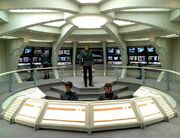
The Prometheus' Main Bridge as it appeared during the Romulan hijacking of 2374
The fact that the Prometheus class was mainly designed for combat was reflected in the design of its main bridge. The bridge was obviously designed with efficiency in mind, providing the commanding officer with visual access to all major stations when seated in the command chair. Directly in front of the captain's chair, sunken down with three steps, was the location of the operations manager and conn stations, combined in one large console. Both officers shared an unobstructed view of the main viewscreen with the commanding officer. All other stations were mounted against the wall, running around the entire length of the room. Directly aft of the captain's chair was the master systems display, and to the captain's left and right were doors that both provided access to a turbolift and deck one, respectively.
USS Prometheus' main bridge refit floorplan
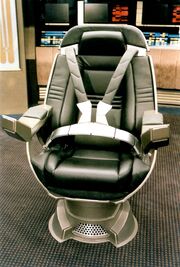
Mark Seven Captain's Chair
As of stardate 57540 (2380) the bridge of the Prometheus had undergone minor refits including the replacement of the Captain's chair with the new mark seven command chair; with independent inertial dampening, safety restraints, and arm mounted computer interfaces. During the refit a dias raised one step above the main level of the bridge was installed to serve as a base for the Mark Seven command chair. The rest of the bridge refit consisted of a significantly larger viewscreen and master systems display, the addition of consoles facing the viewscreen to the two forward most stations on the bridge's main level, and the addition of two bridge weapons lockers located in the deck in front of the environmental control station and mission operations stations the controls for which were located on the tactical station, First Officer's station, and Captain's chair command interfaces.
Auxiliary/Battle Bridges
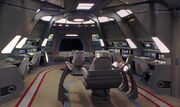
One of the Prometheus' battle bridges
Due to the fact that the Prometheus is able to split into three separate sections two auxiliary bridges were included during the construction of the ship for use when each section is acting independently of the others. One of which is located in the middle or Beta section and the other is located in the lower or Delta section. Each of these battle bridges are fully equipped command centers which can, if the need should arise, take over control of the main bridge functions. The design for battle bridges of the Prometheus were a re-use of the design for the main bridge of the Defiant-class. Since each section of the Prometheus is a pure combat design the designers felt that there was no need to design a new battle bridge since the design for the Defiant-class' bridge was more then suitable for the task.
Captain's Ready Room
Like most Federation starships the Prometheus is equipped with a Captain's ready room for the captain to perform administrative work with all relevant office equipment at hand as well as hold private discussions and/or receive classified communications. The captain's ready room is located port of the main bridge. The Prometheus 's ready room was based on the design of the Intrepid 's ready room with minor modifications.
The desk, which features a work area and computer access panels, is the focal point of the room, located in front of the main entrance door. A raised level in the aft section of the room features a small table, a curved couch and a food replicator. Unlike the Intrepid 's ready room the bulkhead behind the couch on the Prometheus ' has no windows and is facing aft. A shelf beside the main work desk allows the commanding officer to display personal belongings, As of 2378 Captain MacLeod used this shelf to display a set of bagpipes.
Behind the desk, on specially installed wall mounts Logan displayed the eight hundred year old clan MacLeod claymore with a sash in the color and pattern of the Clan MacLeod tartan draped over the handguards and behind the handle. Prominently displayed in a corner of the raised aft level, opposite the replicator, was a four hundred year old Swiss-made Grandfather clock.
Conference Room
The Prometheus' was equipped with a conference room, like most Starfleet vessels, which possesses a large viewscreen. Unlike the Observation lounges of the Galaxy class and Sovereign-classes the conference room of the Prometheus does not possess the panoramic set of windows common in other lounge designs.
Sickbay
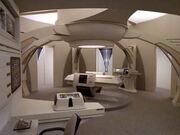
The Prometheus' sickbay as it appeared in 2374.
(As viewed from behind the nurse's station)
The sickbay's original configuration consisted of a circular surgical area with a single bio-bed on a slightly raised dais and a computer workstation a few feet from the bio-bed and an office area to the aft of the surgical area. Around the surgical area was a circular walkway which provided access to the office area and surgical area while still affording the surgical area with a degree of privacy. Between the surgical area and the chief medical officer’s desk, which faced the bio-bed and was in a recessed alcove with LCARS computer access panels on the wall of the alcove, was a duty nurse’s station and pharmacy station.
Should the need arise the Prometheus' sickbay is supplemented by the Emergency Medical Protocol, which when initiated automatically activates the trauma ward program in all of the holodecks which recreates a fully equipped trauma ward. In addition during an emergency selected deck panels are beamed from sickbay to a cargo bay while bio-beds are simultaneously beamed into place in sickbay and connected by engineers standing by in sickbay.
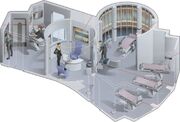
The Prometheus' sickbay as of mid - late 2379
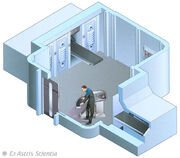
The Prometheus' morgue as of mid - late 2379
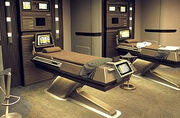
The bio-beds in the 2379 Sickbay refit
As of stardate 56201, The Prometheus' sickbay underwent a major refit and upgrade as a result of Starfleet Command becoming aware of the woefully under equipped nature of the original configuration in regards to cases of multiple patients need to be treated at the same time with little or no fore warning. As a result the Prometheus' sickbay was upgraded so its simultaneous treatment capabilities equaled those of the Intrepid class' sickbay. The new sickbay is equipped with the chief medical officer's office, a load-out of three bio-beds along one wall and one dedicated surgical bio-bed in the surgical bay, a small med-lab, and an expanded ship's morgue acessable via the med-lab. As a result of the upgrades to the sickbay the Prometheus' medical capabilities were significantly expanded thereby allowing the ship to potentially be assigned to more medical oriented missions than previously possible given sickbay's original configuration.
Computer System
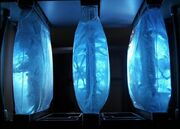
Three of the Prometheus' many bio-neural gel packs.
The Prometheus was outfitted with a state of the art, custom, computer system programmed with the most up to date LCARS computer software and computer database. The computer system is formally known as the M16a tri-core bio-neural gel pack isolinear III processor. The M16a tri-core bio-neural gel pack isolinear III processor is a variant on the standard mark sixteen multi-tronic computer equipped with third generation Isolinear circuitry and bio-neural gel packs. The differences between a M16 bio-neural gel pack isolinear III processor and a M16a tri-core bio-neural gel pack isolinear III processor are the addition of a third computer core, as compared to the standard two, to assist in coordinating the second docking system and speed up communications while the ship is in multi-vector assault mode, and the use of second generation bio-neural gel packs which contain one point five times the synthetic neurons as standard gel packs resulting in a fifty percent increase in data transmission and processing.
In addition to the main computer system the Prometheus is equipped with two secondary cores which are brought on-line during the Multi-Vector Assault Mode and take over the main computer functions for those sections for the duration of the separation.
Emergency Medical Hologram
The Prometheus had been outfitted with the prototype of the Mark II EMH at the time of her hijacking by Romulans in 2374. By 2378 the Mark II had been succeeded by the Mark III and Mark IV EMHs. With the installation of each EMH the Prometheus' EMH back-up module for the previous version of the program was removed, placed in storage for eventual transfer to the Starfleet Corp of Engineers, and replaced with the back-up module for the present version of the program. Providing the communications links between the three sections of the ship are fully functional the EMH can be transferred between the sections if necessary, however this procedure is not recommended as the EMH can be permanently lost if the communications are disrupted during the transmission.
Emergency Command Hologram
By Stardate 57540 the Prometheus had been outfitted with the prototype of Starfleet's Mark I Emergency Command Hologram which was based on the ECH extension that was added to the starship Voyager 's Mark I EMH. When installed protocols were established for the chain of command regarding the ECH which stated the ECH was merely an command advisor and could only assume command of the ship if all members of the senior staff were incapacitated. However the ECH command protocol did state that the ECH could be given temporary command (i.e. as in while the Captain was off the bridge or command of bridge for night shift) of the bridge like any other officer.
Science Labs
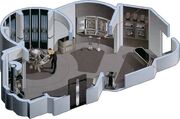
One of the Prometheus' Science labs
The Prometheus is equipped with four standard science labs that are equipped with standard equipment for the Sovereign class starship's science labs. Each of the labs can be refitted with minimal to moderate effort for specialized purposes at the Captain's discretion. Among the various possible configurations (for which supplies are maintained onboard ship) for the science labs are:
- Long-term Patient Care Ward
- Dedicated Surgical Ward
- Decontamination Ward
- Cloning/Biological Researh Lab
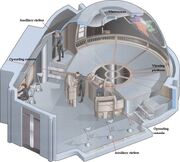
The Prometheus' Astrometrics Lab
The Prometheus is also equipped with a Stellar Cartography/Astrometrics Lab visually identical to Voyager's Astrometrics Laboratory, but equipped only with Federation technology.
As of stardate 56201 (2379), The sensors of the Prometheus were augmented with by the installation of additional sensor pallets, which were developed for the Luna class of starships
Main Engineering
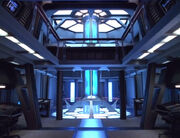
The Prometheus' Main Engineering section
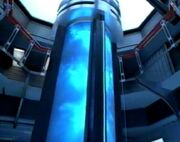
The Prometheus' Warp Core
The Prometheus' main engineering is visually identical, and from an engineering standpoint nearly identical, to that of the Intrepid-class' due to the fact that the two classes share common elements and some design lineage. The main difference between the two types on engineering are the corresponding changes for and to the Gravimetric Field Displacement Manifold, more commonly known as the warp core, due the multi-vector assault mode.
The Prometheus is also equipped with two Auxiliary Engineering compartments which serve as "main engineering" departments for their sections when the multi-vector assault mode is initiated/engaged. These sections are not as large as the Main Engineering compartment because of their secondary nature, but are none the less more than adequate to serve as a temporary main engineering when the multi-vector assault mode is engaged or if main engineering is somehow disabled/inoperative. To further enhance this each of the engineering compartments is equipped with over-ride circuits specifically designed to allow the remote control of the other engineering sections.
The Prometheus was equipped, during its construction, with the navigational deflector design from the Akira-class enhanced with elements from the Sovereign-class starship's navigational deflector design. The enhancements allow the navigational deflector to operate with a marked increase in efficiency at higher warp speeds.
In spite of the fact of that the deflector design was used for a vessel with a lower maximum warp speed the Starfleet designers in charge of the Prometheus Project felt that the design was still suitable (with minor modifications) since it was designed for a vessel with a wider beam measurement and a greater bow to stern length and a mass roughly 3.59411 times greater then that of the Prometheus.
Warp Core/Anti-Matter Pod Ejection
In the event of an imminent warp core breach the Prometheus class starship, like all 24th century Starfleet vessels, is capable of ejecting is warp cores and/or its anti-matter pods depending on the severity of the situation. Either procedure requires the authorization code of the chief engineer or a member of the senior staff. The core and pods are ejected through dedicated ejection ports on the underside of the secondary hull. Magnetic rails inside the channels accelerate the core/pods once disengaged from the vessel, and fire it away from the ship. Under normal circumstances, the vessel then moves away from the core/pods as fast as possible under impulse power. Should the core not go critical, then the vessel can recover it by use of tractor beams and careful manipulation. The anti-matter pods are likewise capable of being retrieved and reinstalled, although their re-installation is more complicated due to the volatile nature of anti-matter. It is not unheard of, although it is by no means common or encouraged by Starfleet Command, for an anti-matter pod or pods to be ejected so its/their detonation can be used as a part of a combat maneuver.
Landing And Atmospheric Flight
Being a ship belonging to one of the few Starfleet starship classes capable of atmospheric entry and planetary landing, the Prometheus starship is equipped with hybrid microfusion and EM driven airflow atmospheric thrusters as well as anti-gravity lifters and landing struts strategically placed at the mass and stress points on the ventral surface of the secondary hull. Prior to and during landing or taking off procedures, the vessel typically goes to Blue Alert, indicating to the crew they are to assume their code blue stations.
Emergency Containment
The Prometheus is equipped with an emergency bulkhead system designed to protect the majority of the Prometheus' crew in the event of a hull breach and the failure of the atmospheric containment forcefields. The emergency bulkheads on the Prometheus are set up at every junction point between each major section.
Auxiliary Systems/Features
The Prometheus, like the Sovereign-class, was equipped with a Manual Navigation Control System for use in precision and emergency sublight maneuvering via the manual steering column located in the Flight Control Console. The system was installed with the intention of providing and intuitive control method for use when the normal flight controls are inoperative.
Shuttlebay
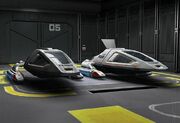
Two Type 9 shuttles in the Prometheus' shuttlebay
Located in the aft dorsal portion of the secondary hull, the shuttlebay of the Prometheus is based largely on the design of the Intrepid-class' shuttlebay and is the only point of entrance and egress for auxiliary craft, as well as management of said craft. The shuttlebay is managed by a team of pilots, engineers and technicians, and operations personnel under the supervision of the Chief Flight Control Officer and Chief Operations Officer. Located behind the shuttlebay (closer to the bow) is a the maintenance bay. This secondary area is almost as large as the main shuttlebay and is where all shuttle maintenance takes place. Shuttles and cargo are moved from the the shuttlebay to the maintenance bay by way anti-gravity lifts (for cargo) and by the shuttle using its own anti-gravity lifters.
Auxiliary Craft
The Prometheus is equipped with the following types and numbers of auxiliary craft:
- 1 Type-11 shuttlecraft (Deucalion NX-59650/1) (Prior to Stardate 55118)
- 1 Yellowstone-class Runabout (USS Banff) (Subsequent to Stardate 55118)
(Assigned to replace the destroyed Type-11 shuttlecraft Deucalion) - 2 Type-9 shuttlecraft (Equipped with custom tetryon warp plasma nacelles for high warp capabilities)
- 4 Work Bee class EVA pods
- 21 8-Person "Prometheus class" escape pods
Gymnasium
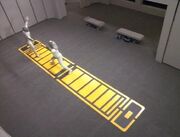
The Prometheus' fencing room
The Prometheus, like most Federation starships, is outfitted with a gymnasium for crew recreation. The Prometheus' gym included change facilities, a pool, a work-out room, a multi-purpose room, a parrises squares court, and a dedicated fencing room.
Mess Hall
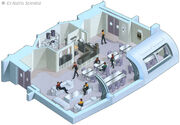
The Prometheus' Mess Hall
On the Prometheus, the design of the mess hall was borrowed from the Intrepid class and was placed on deck five, section thirteen. The particular configuration of the Prometheus' mess hall was identical to the configuration of the Intrepid class' mess hall with the Captain's private dining room reconfigured into a galley. The mess hall aboard the Prometheus' was host to many social gatherings including the change of command ceremony in which Logan formally assumed command of the Prometheus.
Holodecks
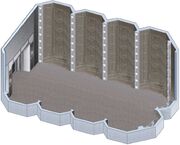
One of the Prometheus' holodecks
The Prometheus has been equipped with two holodecks for both entertainment and training purposes. Like all other Federation holodecks the holodecks on the Prometheus are capable of running programs in either objective (Non-participatory) or subjective (participatory) modes. The Prometheus' holodecks are equipped with safety protocols to prevent serious injury during their use, perceptual filters for holographic characters, spatial orientation sub-systems, and are capable of playing a wide assortment of holograpic programs.
Onboard the Prometheus, like on all Starfleet vessels equipped with holodecks, the holodeck safety protocols on the Prometheus can be disengaged when required. but only by a senior officer, however to ensure safety for the participant(s), any person onboard ship can reactivate safety protocols as long as they are within the holodeck or at the control panel outside the holodeck. On the Prometheus a record is automatically made of all times the safety protocols are disengaged and by whom. This record is accessible by all senior staff but can not be deleted by anyone onboard the ship in the event that the record is needed to document a pattern of self harming behavior.
Transporters
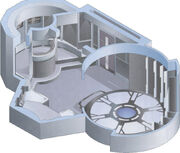
One of the Prometheus' transporter rooms
The Prometheus has been equipped with the standard transporters that have been installed on ships constructed since the construction of the Intrepid-class starship. Like all Starfleet transporters the ones onboard the Prometheus had a normal maximum range of 40,000 kilometers, although in an emergency this can be extended by tying the transporter system into the navigational deflector. While tying the transporters into the navigational deflector does extend the range of the transporter it also severely limits the number of places a person can be transported to/from.
By stardate 56201, due to the "tinkering" the Prometheus' Lieutenant commander Durgan Morlon, Master chief petty officer Joshua Gunn, Ensign D4 Green, Gorn Hegemony exchange officer Korsha, and Lieutenant junior grade Kiaphet Amman'sor the transport cycle for the transporters on the Prometheus and the USS Banff were reduced from five to four seconds. Like all Starfleet transporters the transporters onboard the Prometheus have the same limitations regarding shielding, transport inhibitors, and naturally occurring transport inhibiting minerals/formations/events.
Brig
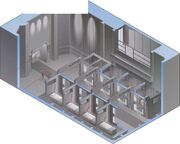
The Prometheus' Brig
Like all Starfleet vessels the Prometheus has been equipped with a brig to facilitate the confinement of individuals who must be detained - such as dangerous individuals, criminals, and crew members found guilty of violating Starfleet regulations. On board the Prometheus, the brig is a heavily guarded room containing multiple cells, a control console, a reinforced security door, and a overhead observation platform.
Jefferies Tubes
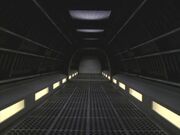
One of the Prometheus' many horizontal Jefferies tubes
Like all Starfleet vessels and installations the Prometheus is equipped with Jefferies tubes to allow the crew access to various ship's systems. In emergencies when the turbolifts are inoperative, the Jefferies tubes can also used for moving around the ship. Doors within the Jefferies tubes can be sealed for safety or security reasons. It should be noted that on all ship displays of internal structure Jefferies Tubes are not displayed.
Crew Accommodations
One third of the quarters onboard the Prometheus are special variable environment quarters for crew/guests with special requirements, the remainder of the quarters are standard M-class atmosphere quarters designed for humanoids and near humanoids. The Prometheus is equipped with the standard outload of cabin/quarter types which consists of the following cabin types:
- V.I.P. quarters:
- The V.I.P. quarters contain a living area, a bedroom, a bathroom, as well as a large desk area and work terminal. The quarters feature four windows, which offer an excellent view of space. These quarters are reserved for visiting ambassadors, dignitaries, and other high ranking officials.
- Captain's quarters:
- The captain's quarters contain a living area, a bedroom, a bathroom, as well as an office containing a desk and work terminal. The quarters feature five windows in addition to the window in the office all of which offer an excellent view of space in front of the vessel.
- Officers' quarters:
- These quarters line the edge of the saucer section and contain a living area, a bedroom, and a bathroom. They are generally reserved for those of ranking lieutenant (full grade) or higher and members of the senior staff, regardless of their rank. Senior staff members are typically assigned quarters featuring a pair of large windows.
- Guest quarters:
- Like the Officer's quarters these quarters line the edge of the saucer section and contain a living area, a bedroom, and a bathroom.
- Standard crew quarters:
- These small quarters units are located within the primary hull and lack windows. They are comprised of a living area, a bedroom, and a bathroom. The living area contains a replicator terminal and is customizable with a variety of furniture and decorations. Crewmembers of lieutenant junior grade and Ensign ranks are given their own quarters, as are non-commissioned officers of the rank of chief petty officer; non-commissioned officers below the rank of chief petty officer are required to share quarters.
Personnel Equipment
When assigned to active duty the Prometheus was equipped with all of Starfleet's standard issue personnel equipment, which includes but is not limited to:
- Standard Starfleet PADDs
- Mark XI Tricorders
- Type IIIa EVA Suits
- Type 1 Phasers
- Type 2A Phasers
- Type 3B Phaser Rifles
- EVA Phaser Rifles
- Photon Grenades
- Photon Grenade Launchers
In addition to the standard personnel weaponry the Prometheus' was also stocked with the following non-standard equipment:
- Isomagnetic disintegrators
- Tetryon pulse launchers
- Transport inhibitors
- TR-116a Tactical Sniper Rifles
- TR-120 Magentic Pulse Rifles
- Mark III Starfleet Hazard Suits
- Isolation suits
Crew
Senior Staff
- Commanding Officer: Captain Logan MacLeod
- First Officer, Communications Officer & Records Officer: Commander Solen
- Chief Tactical Officer, Second Officer & Intelligence officer: Lieutenant Commander Garav Rimosi
- Chief Engineer & Third Officer: Lieutenant Commander Durgan Morlon
- Chief Operations Officer & Quartermaster: Lieutenant Gleicy Ruiz
- Chief Flight Control Officer: Lieutenant Jonathan Sulu
- Chief Science Officer: Lieutenant Commander T'Wan
- Chief Medical Officer: Doctor (Lieutenant Commander) Atana Ral
Other Crew
- Assistant Chief Engineer: Lieutenant Lisa Westgate
- Assistant Chief Flight Control Officer: Lieutenant Junior Grade Kiaphet Amman'sor
- Engineer: Ensign D4 Green
- Transporter chief: Master chief petty officer Joshua Gunn
- Emergency Medical Holographic Program AK-1 Diagnostic And Surgical Subroutine Omgea 323 Mark IV
- Chef: Tedak
As of 2379 (specifically stardate 56201) the crew also includes:
- Engineer: Lieutenant Tarag
- Operations officer: Ensign Igmar
- Engineer: Petty Officer Third Class Celes Tal
- Engineer & Auxilliary Bridge Officer: Korsha (Exchange officer from the Gorn Hegemony)
- Command Advisor & Bridge Officer: Emergency Command Holographic Program AK-1 Command and Tactical Subroutine Omega-323 Mark I
Ships of the class
| Prometheus-class starships |
|---|
| Prototype: USS Prometheus - USS Prometheus (PDN) - USS Prometheus (Prometheus) |
| USS Aegis - USS Alaska - USS Bell - USS Black Knight - USS Cerberus - USS Constitution - USS Gerentaika - USS Hercules - USS Interstellar - USS Mawson - USS Milan - USS Niagara - USS Olympus - USS Ottawa - USS Pandora - USS Phoenix-X - USS Praetorian - HMS Prometheus - USS Titan - USS Tombstone - USS Zealous |
| Mirror Universe: ISS Phoenix-X |
| Constar Completed: USS Raincross |
| Starfleet International: USS Blackstone - USS Jaresh-Inyo - USS Panther - USS Resolute - USS Tydirium |
| Trekmania: USS Ariel - USS Earnest - USS Guardian - USS Miranda - USS Nirvana |

|
This is a Star Trek Expanded Universe featured article. We believe that it is well put together, informative and one of the best examples of the wiki's work. If you see a way to improve this page further, we invite you to contribute. To see other featured articles, click here. |
External link
- USS Prometheus (NX-59650) (Prometheus) article at Memory Beta, the non-canon Star Trek wiki.
